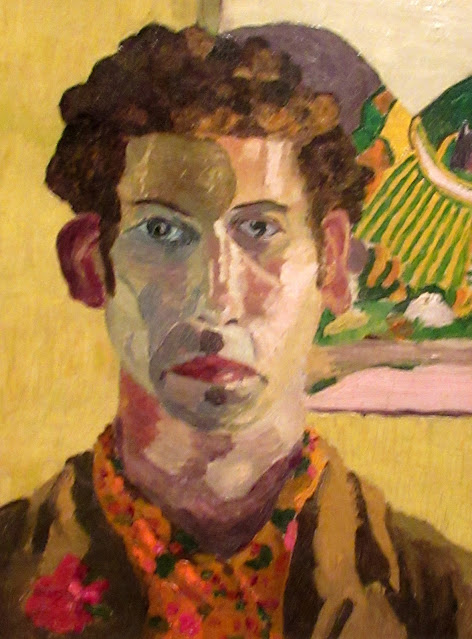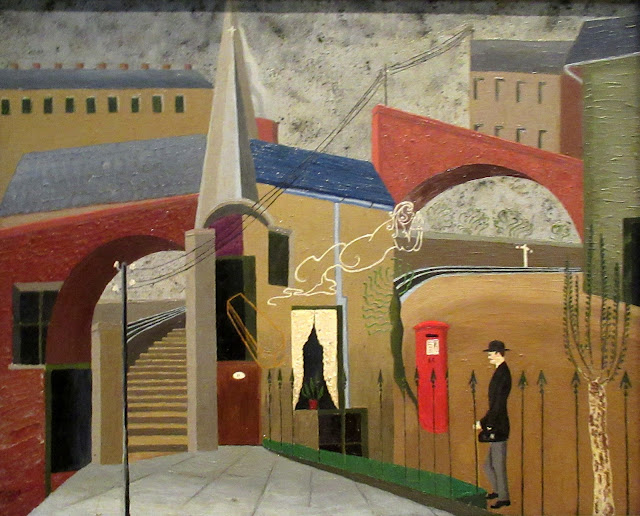Art 100 at the National Museum, Cardiff.
An interesting initiative: a display of the most popular artworks from the whole collection of the museum. This is how this initiative was explained to us:
Whose art is it anyway?
Wales' national art collection belongs to everyone, but in the past, only a few had the power to decide what's collected and how it's presented.
Is this fair? Who gets to choose what we see?
The curators at Amgueddfa Cymru selected 100 art works from our collections that we shared on Instagram, encouraging followers to like, comment, and share their favourites. Valuable lessons were learned and surprisingly, some works we thought would be popular didn't resonate online as much as contemporary pieces. From the responses, we compiled a shortlist of the most popular artworks, now on display in this gallery.

During our visit the museum was packed, and there were lots of school trips of students of all ages. The most well-behaved ones were this group: they were engaged, attentive and interested.
Now the collection:
Rachel Whiteread, Untitled (History), 2002, (plaster, polysterene and steel)
Books are repositories of our shared culture. This work was made by casting the space around a set of bookshelves. The books themselves are absent, only their ghostly traces remain. Whiteread has created a series of these sculptures that act as a form of memorial. Untitled (History) suggests how easily collective memory can be lost.
Gwen John, A Corner of the Artist's Room, 1907-08, (oil on canvas)
John paints a self-portrait with no-one in it. The discarded clothes and open book suggest an invisible presence, while the muted tones and simple forms convey a life of calm, order and self-containment.
Thomas Jones, Buildings in Naples, 1774, (oil on paper)
With its dusty blue and silver-grey tones and unusual cropping, this small oil sketch looks refreshingly modern but was actually painted in the 18th century. It was a private study, never meant for display. Its jewel-like quality has captured public imagination.
Richard Deacon, Tall Tree in the Ear, 1983-84, (galvanised steel, laminated wood, canvas)
Deacon calls himself a 'fabricator' who makes 'fabrications' by assembling parts rather than using traditional sculpture methods of carving or modelling.
Kevin Sinnott, Running Away with the Hairdresser, 1995, (oil on canvas)
'A momentary slip into fecklessness... a mature scepticism towards youth's arrogance'.
David Mash, Multi-Cut Column, 2000, (beech)
Conscious of our human impact on the natural world, Nash's environmentally sympathetic sculptures explore the potential of wood. The multi-cut in this beech-wood column have been allowed to naturally crack and warp to produce the different textures and shapes.
Laura Ford, Glory Glory, 2005, (mixed media)
Cedric Morris, Golden Auntie, 1923, (oil on canvas)
Morris has painted his partner Arthur Lett Haines in a suit and bowler hat walking through a strange, dreamlike city-scape.
Peter Prendergast, Blaenau Ffestriniog, 1993, (oil on canvas)
Blaenau Ffestiniog is a centre of the north Wales slate industry - the town is surrounded by a man-made landscape of quarried slate-tips.
Bridget Riley, Kashan, 1984, (oil on linen)
Kashan is a truly interactive work, reflecting how we perceive colour in nature. The irregular arrangement of stripes creates a visual effect which Riley calls the 'horizontal spread of coloured light'. This perceptual field surfaces when colour groups merge in the eye of the viewer, shimmering and pulsing, shifting with every blink.
George Shaw, The End of Care, 2013, (humbrol enamel on board)
Shaw has createtd a rich body of works around Tile Hill, the suburb of Coventry where he grew up. The End of ... series captures the decline of a mid-20th century housing estate, common throughout the country. This painting features the site of a demolished care home.
Denys Short, Chapel and Tip, 1960, (oil on canvas)
Painted in about 1960, this work has an incredible poignancy in light of the 1966 Aberfan disaster, when a collapsed coal tip killed 116 chilcren. Here, children play at the foot of the Chapel in the shadow of a looming tip - a precarious symbol of both community prosperity and unimaginable devastation.
Kyffin Williams, Storm, Porth Cwyfan, 1995, (oil on canvas)
The painting displays Williams' well-known technique, that of thick, monochrome impasto, broadly applied with a palette knife. It is used here to evoke the drama of a rough sea.
Betty Woodman, Diptych: The Balcony, 2007, (glazed earthenware, epoxy resin, lacquer, paint)
Adam Buick, Massive intertidal Jar, 2015, (stoneware with Waum Llodi clay, natural bluestone plinth)
Buick incorporates local materials in his moon jars. This one has Waum Llodi clay splashed on the surface and a plinth of natural Pembrokeshire bluestone.
Clare Woods, Hill of Hurdles, 2010, (oil and enamel on aluminium)
Woods often focuses on overlooked elements of landscape - from stagnant pools to thick undergrowth. Locations are photographed at night and collaged to create the painting's final composition. The high gloss finish contributes to Woods' description of her work as 'supernaturally charged'.
Claire Curneen, In the Tradition of Smiling Angels, 2007, (terracotta, gold lustre)
The gold lustre on these two angels symbolises the preciousness of blood and reminds us of our mortality, but their gentle, mysterious smiles make them a comforting presence.

Elizabeth Fritsch, Blown-Away Vase, Over the Edge, Firework XII, 2008, (stoneware)
Lucie Rie, Set of four cups and saucers, 1958, (porcelain)
Lucie Rie, one of the greatest 20th-century potters, escaped Nazi-occupied Vienna in 1938 and settled in London where she earned success with her refined modernist style of ceramics.
Frank Bowling, Caesar's Plume, 1975, (acrylic on canvas)
In 1973 Bowling began a series of abstract works known as 'poured paintings'. Canvases were set-up at a 45-degree angle and paint was poured down the surface to create marks and patterns led by chance. In 2005 Bowling became the first black artist to be elected as a member of the Royal Academy.
Martin Parr, Snowdonia, Wales, 1989, (pigment print)
A couple with contrasting priorities; one takes in the breath-taking landscape of Eryri
National Park, whilst the other, seemingly obvlivious to the views outside, catches up on tabloid news.
Clementine Schneidermann, Charlotte James, It's Called Ffashiwn, (Look It Up), Merthyr, 2016, (C-type print)
The girls' funereal, gothic clothing paired with their sombre, self-assured expressions provokes an element of timelessness that makes them appear older than their years.































































